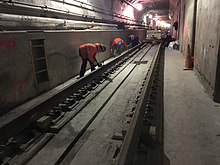63rd Street Tunnel
The lower level carries Long Island Rail Road (LIRR) trains to Grand Central as part of the East Side Access project.
During construction, the lower level was used to move materials between the work sites in Manhattan and staging areas in Queens.
[3] Several months later, on October 17, the Board of Estimate approved a new East River tunnel sited at 64th Street, noting that it would cost $30 million and take seven years to build.
[7] In November 1967, voters approved a $2.5 billion transportation bond issue, and in early 1968, under the Program for Action, officials provided detailed plans for how it would be used.
[11] Four 38-foot-square (12 m) prefabricated sections of the 63rd Street Tunnel were constructed at Port Deposit, Maryland, then towed to New York and sunk under the East River.
[18] In June 1970, Mayor John Lindsay told city engineers to write a report that studied ways to reduce the project's impact.
[18] The results of the report, released in January 1971, called for using tunnel boring machines underneath Central Park to reduce disruption.
[19] The following month, the NYCTA published advertisements in newspapers, seeking construction bids for the tunnels under Central Park, but withdrew them after objections from community and conservation groups.
[20] The NYCTA agreed to halve the width of the proposed 75-foot (23 m)-wide cut, which resulted in a proportionate decrease in the area of affected parkland.
[26] The upper level was completed in 1976, but due to the 1975 New York City fiscal crisis, there was no funding to extend the tunnel in Queens east of the 21st Street–Queensbridge station.
[27] The New York Times reported that the lower level of the 63rd Street Tunnel was still under construction by 1976, even though it would remain unused indefinitely.
[28] Richard Ravitch, the MTA chairman, said that to stop the work was "so costly as to make it impractical subsequent to the construction of the subway portion.
[32] By June 1985, the project was again delayed indefinitely after it was found that the tunnel had been flooded with 6 feet (1.8 m) of water, and several girders and electrical equipment had also deteriorated.
[38] The remaining section from 21st Street to the Queens Boulevard Line, which cost $645 million, began construction on September 22, 1994.
[50]: 1 [a] Two months later, the Federal Transit Administration (FTA) gave a favorable "Record of Decision", a mark of approval, to East Side Access after reviewing the project's FEIS.
As LIRR president Kenneth J. Bauer stated, "If something happened at the East River tunnel, you wouldn't be able to run trains to Penn Station.
[37][60] An $83 million cut structure was built, which extends the tracks under Northern Boulevard into the Sunnyside Yard, and then was covered with a deck.
[69] The MTA upgraded cellular service within the Grand Central Madison station and surrounding tunnels in late 2023.
[70][71] Additionally, at the time of the Grand Central Madison station's opening, the LIRR did not own a "rescue locomotive" that was small enough to tow disabled passenger trains through the 63rd Street Tunnel; its existing locomotives could only fit the larger dimensions of the East River Tunnels.
[78]: 45 Waste material from the 63rd Street Tunnel's construction was deposited at the tip of Roosevelt Island, as well as off the coast of Astoria, Queens.
[69] Since then, they are used by the Long Island Rail Road to connect Queens and the Grand Central Madison station, which was constructed as part of the East Side Access project.
[68] Due to low vertical clearances in the lower level, bilevel rail cars, such as the LIRR's C3 fleet, are not able to serve Grand Central Madison.
[78]: 68–71 Additional ventilation shafts are located at Second Avenue and 63rd Street in Manhattan,[78]: 30 and on the western shore of Roosevelt Island.
[81] The 63rd Street Tunnel Connector was also selected as the Transit Project of the Year in 1999 by New York Construction News.


